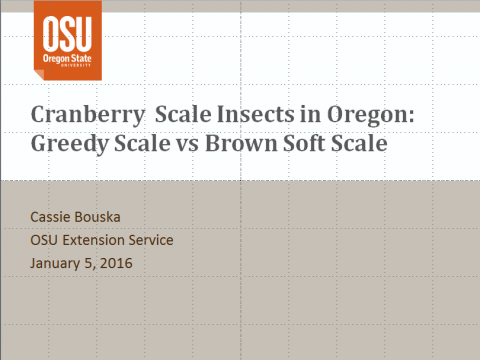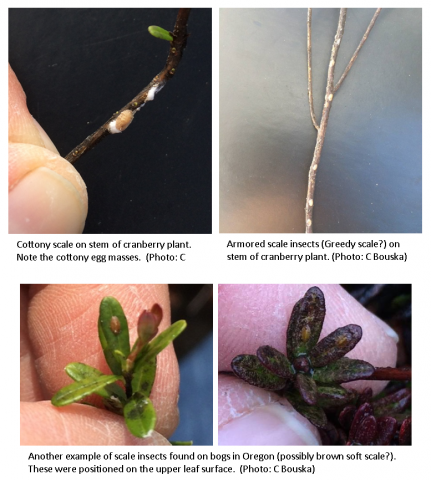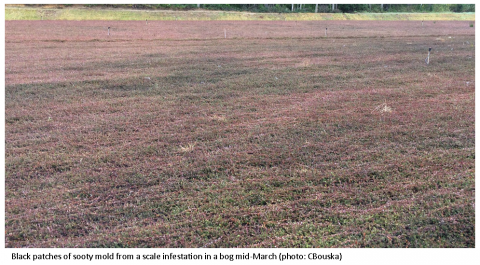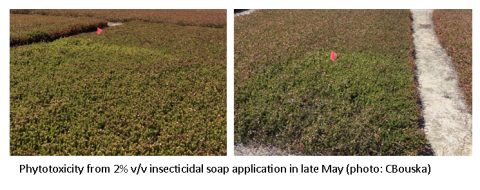Scale Insects
Presentation given at April 12, 2016 Twilight Meeting.
GENERAL INFORMATION ON SCALE INSECTS IN OREGON
The Big Picture: Potential negative impacts of scale infestations in cranberry bogs include:
- Stunted, delayed vine growth
- Potential fruit loss from sooty mold
Scale insects are sucking insects that infest vines and leaves of cranberry plants. They are often difficult to detect because 1) they are small, and 2) they are relatively immobile.
There are two basic types of scale:
- Armored scales -- These scales have a platelike cover (the "armor") that can be peeled off or removed. Underneath this armor is the actual scale insect. When you remove the armored cover, the scale insect should remain on the plant. The cover itself looks sort of like the shell of a clam, with concentric rings often forming as the insect grow and adds layers to it. They often have a slight protuberance (exuviae or "nipple") that is of a different color from the rest of the cover. (This is exactly what we see with greedy scale). Armored scales don't produce honeydew.
- Soft scales -- Soft scales have a smooth, cottony, or waxy surface. With the exception of brown soft scale, they tend to be larger and more rounded (humped) than armored scales. They don't have a removable armored cover; the cover they secrete is fused with their body so that when you flip them over, the entire body flips and peels away from the plant surface. Soft scales excrete a lot of honeydew, which is what sooty mold grows on. Brown soft scale, lecanium scale, and cottony scale are all soft scales.
There are several species of scale insects that have been detected in cranberry bogs in Oregon (see Cranberry Production in the Pacific Northwest for more information). In 1992, there was an infestation of brown soft scale. More recently, during the late winter/early spring of 2015, isolated incidents of scale infestations were reported on several farms in southwestern Oregon.
In 2015, we have identified several species of scale in Oregon cranberry beds:
- Greedy scale – Greedy scales are an armored scale (vs a soft scale, like cottony and brown soft scale) reported to have two generations per year in New Zealand, so it’s likely that they have more than one generation per year in our area as well. When we examined greedy scale samples in mid-November of 2015 we found crawlers present, so it is possible that they have more that 2 generations in our area. Greedy scales don't produce honeydew, so they don't contribute to the sooty mold problem in cranberry beds. However, they are very prolific and can cover the stems of the vines, creating dead spots in beds.
- Brown soft scale – These are small, brownish scales that spend the winters on uprights and leaves. All sizes of brown soft scale can be found throughout the year. This is the species of scale that was first noticed in 1992 in a few bogs in our area. Brown soft scales produce a lot of honeydew, which is what sooty mold grows on. They overwinter as immature scales (nymphs) on leaves, and produce at least two generations per year ... perhaps more in our area. Observations of brown soft scale in November 2015 suggest that crawlers may be present in the late fall as well.
- Lecanium scale - We are unsure how prevalent this scale species is in our area. Some Lecanium scale were present on cranberry vine samples taken in November 2015, but they were not as prevalent in the samples as were brown soft scale and greedy scale. They only produce one generation per year, with crawlers emerging in June (WSU EB 1552E).
- Cottony scale – These are soft scales that lay their eggs in cottony masses. We found cottony scales on the stems and undersides of leaves in early June. Cottony scales are not listed in the Pacific Northwest Insect Management Handbook as one of the common pest scale species on cranberries, so they are probably not a major concern. They only have one generation per year. Some of the dead cottony scales in the samples we sent up had parasitoid wasps inside them, indicating that some biological control is in effect.
Regardless of the kind of scale that is present, it is important to know what to look for when monitoring your bogs for scale presence. The first things growers with scale have noticed is blackened patches in their bogs. Sometimes these have been fairly small (just a foot or so in diameter), but in other situations (like the photo below), these patches are very large.
Scale insects are sucking insects that excrete a sugary, watery substance called “honeydew.” This provides a fantastic substrate for sooty mold to grow. Sooty mold is what creates the black patches in the bog, and is actually caused by several different fungal species. It coats the leaves and stems of the affected plant with a crusty or velvety black growth. Sooty mold is not toxic, but according to one local Oregon grower, it can affect the taste of cranberries when it covers them. This particular grower ended up disposing of a fairly large amount of berries from a scale infested bog because of sooty mold contamination.
Why are we seeing scale now???? It could be because of the warm winter we had this year. Or, it could be a result of our using “softer” insecticides. We don’t really know. What we DO know is that it’s a manageable problem, and that’s always a good thing.
So … What do we do about it??? For both brown soft scale and cottony scales, earlier research showed that a 2% solution of insecticidal soap can be applied to smother overwintering forms. This was found to be effective alone, but also if used in conjunction with an organophosphate. Other control measures are aimed at the susceptible ‘crawler’ stages. Because of this, it is very helpful to know when crawlers are present. A WSU publication (WSU PLS-63) provides the following information on monitoring for crawlers:
“A crucial step in scale insect management is determining when the crawlers emerge. A hand lens or magnifying glass will help you to examine the plant to determine when this happens. Double-sided sticky tape may be applied near adult scales to trap crawlers as they migrate to new growth. For convenience, you may put an infested branch in water to keep it from drying out and leave it outdoors in a shady place. Observe the scale eggs every few days for a hatch. Chemical management strategies must be timed to coincide with emergence of the crawlers. Remember that emergence times will vary depending on your location and seasonal weather conditions, so do not depend on notification from other sources or areas. Monitor your own [bogs].”
Once you’ve determined the appropriate timing for treatment on your farm, consult the Pacific Northwest Insect Management Handbook for the most recent information on what to use for the control of scales in cranberries. Here are the current (as of July 2015) recommendations:
- Azadirachtin (Aza-Direct, Neemix and other brands). Consult label for rate. PHI 0 days. Some formulations are OMRI-listed for organic use.
- Insecticidal soap (M-Pede and other brands), alone or with chlorpyrifos (Lorsban and other brands). PHI 0 days. Consult label for rate and use directions. Some formulations are OMRI-listed for organic use. Use high label rate of soaps when used alone; use lower rate if used with chlorpyrifos. Spot-treat infestations in dorman period at 1 to 2% v/v solution.
Several growers have tried different combinations of treatments at different times during the year.
Growers who applied tank mixed insecticidal soap and an OP in late winter/early spring (prior to, or just at, bud break) had good success and didn’t see any phytotoxicity issues.
Another grower experimented with applying a 2% v/v solution of insecticidal soap by itself in late May. He had good control and slight phytotoxicity. In the photos below, you can see the light green portions of the bog where the insecticidal soap was applied. Had it been applied earlier in the season while the plants were still dormant, phytotoxicity would not have occurred.
We are currently in the process of gaining more information about the lifecycles of the scale we have in our area. We were suprised to see crawler activity in November, but it's good information for us to know. As of November 2015, we are testing the possibility of using post harvest flooding as a mechanism to control the scale with multiple generations (greedy scale and brown soft scale). In addition, we plan to test different chemical control measures during the dormant season this winter in order to provide local, research-based information for most effective control options.
UPDATED November 20, 2015
Cassie Bouska
Coos/Curry Agriculture Extension
541-572-5263 ext 25290
References (and places to go for more information):
- University of California Agriculture and Natural Resources, UC IPM Statewide Integrated Past Management Program. Pests in Gardens and Landscapes: Scales. http://www.ipm.ucdavis.edu/PMG/PESTNOTES/pn7408.html. Accessed 11/20/2015
- Oregon State University. Pacific Northwest Nursery IPM. "A Matter of Scale." http://oregonstate.edu/dept/nurspest/scale.htm. Accessed 11/20/15
- Washington State University Extension Bulletin. EB1552E. "Scale Insects on Ornamentals." http://cru.cahe.wsu.edu/CEPUBLICATIONS/EB1552E/EB1552E.PDF
 Oregon Cranberry Growers Association
Oregon Cranberry Growers Association



